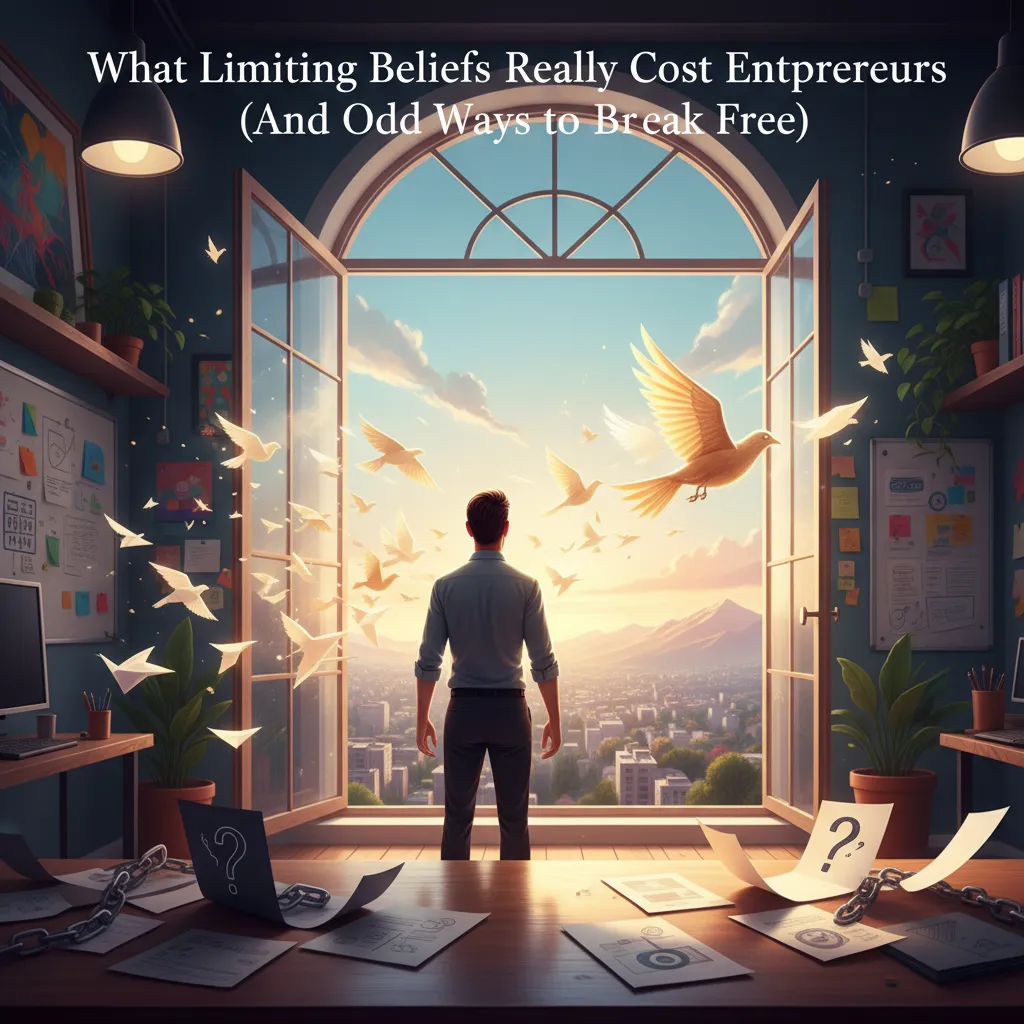I’ll never forget the first time self-doubt almost took me out of the game. Picture this: nineteen, barely scraping by at my first start-up, drowning in negative thoughts louder than complaints at a Monday morning meeting. But what really gets me is this – looking back, it wasn’t market trends or cutthroat competition that nearly made me quit. It was the story I was telling myself about what I could and couldn’t do. Turns out, those quiet little beliefs? They’re the loudest force in the room for any entrepreneur. Let’s unravel how much our own minds might be costing us – and why a few oddball strategies might finally set us free.
The Invisible Roadblocks: My Brush with Self-Limiting Beliefs
When people talk about entrepreneurship, they often focus on external challenges—market competition, funding, or product development. But in my experience, the most powerful obstacles are the ones you can’t see. They’re not out there in the world; they’re inside your own head. These are the self-limiting beliefs that quietly shape your actions, your confidence, and ultimately, your results.
Anecdote: The $300/Month Reality Check
I was 19 when I started my first company. Like many new entrepreneurs, I was full of hope and ambition. But reality hit hard and fast. I was working every single day, pouring my energy into the business, and yet, my earnings were stuck at just $300 a month. That number wasn’t just a financial challenge—it became a symbol of my self-worth. I started to feel like a fraud, convinced I wasn’t cut out for entrepreneurship. The thought loop in my mind was relentless: “I’m not good enough. I don’t have what it takes.”
This is the hidden cost of limiting beliefs. They don’t just slow you down; they can stop you in your tracks. I remember one night, after another long day with little to show for it, I hit my breaking point. I told my business partner, “I quit. I’m done. I need to feel like I have value as a human, and this isn’t working.” I went to bed defeated, certain I would walk away from my dream the next morning.
Belief vs. Reality: The True Saboteur
Looking back, it’s clear that my biggest obstacle wasn’t the market or my product. It was the story I was telling myself. The belief that I wasn’t good enough became a self-fulfilling prophecy. I was so focused on my perceived shortcomings that I couldn’t see any way forward. This is what self-limiting beliefs do—they foster self-doubt and a fear of failure, making it almost impossible to grow or take risks.
Research shows that these beliefs are common among entrepreneurs. They often manifest as:
- Fear of failure or rejection
- Imposter syndrome (“I don’t deserve success”)
- Belief that others have some secret advantage
- Assuming one setback means permanent defeat
These invisible roadblocks can sabotage your business and your life, stealing your dreams and potential before you even get started.
The Morning Epiphany: A Mindset Shift
But something changed for me the next morning. Instead of quitting, I asked myself a different question: “Who has built a successful software company before?” The first person who came to mind was Bill Gates. I started to study how he did it, looking for clues that I could apply to my own journey. One strategy stood out—he formed partnerships to scale his business.
Inspired by this, I decided to model his approach. I reached out, made connections, and soon after, I landed a partnership deal worth $135,000. That was more money than I had ever seen in my life. More importantly, it shattered my old belief. I realized I wasn’t a failure—I just needed the right strategy and the courage to keep going.
Building Confidence Through Small Wins
This experience taught me that building confidence isn’t about waiting for external validation. It’s about taking action, even when you’re scared or uncertain. Every small win chips away at self-doubt. Each step forward proves that your old beliefs aren’t facts—they’re just stories you’ve been telling yourself.
Whether you believe you can do a thing or not, you are right. – Henry Ford
That quote sums up my journey. I believed I couldn’t win, and I was right—until I changed my belief. Once I started to believe in new possibilities, everything shifted. The narrative wasn’t about external circumstances, but about what I believed was possible for myself. Sometimes, the only real competition is the voice in your own head.
So if you’re struggling with limiting beliefs in your entrepreneurial journey, know that you’re not alone. The first step to breaking free is recognizing the invisible roadblocks and daring to rewrite the story you tell yourself.

Why Your Brain Clings to the Same Old Story (And How Science Messes With That)
Let’s get honest about what’s happening inside your head. If you’ve ever felt stuck in a loop of self-doubt or caught yourself replaying the same worries day after day, you’re not alone. In fact, you’re completely normal. According to researchers, the average person has between 12,000 and 60,000 thoughts per day. Here’s the kicker: 80% of those thoughts are negative, and a staggering 95% are the same repetitive thoughts you had yesterday.
So if it feels like you’re constantly battling the same limiting beliefs or negative self-talk, it’s not just you. Your brain is wired to repeat what’s familiar—even if it’s not helpful. This is why Challenging Negative Self-Talk can feel like swimming upstream. But just because a thought is on repeat doesn’t make it true. As Tony Robbins famously said:
The only thing that's keeping you from getting what you want is the story that you keep telling yourself.
Why Your Brain Loves Repetition (Even When It Hurts)
Our brains crave efficiency and safety. Repetition is the brain’s way of saving energy. If you’ve told yourself “I’m not good at sales” or “I always mess up launches” enough times, your brain files that away as a shortcut. The next time you face a challenge, it pulls up the same old story—no need to think too hard or risk something new. This is why Challenging Negative Self-Talk feels so tough: your brain is just doing its job, even if it’s working against you.
But here’s where science flips the script. Just because a thought is familiar doesn’t mean it’s factual. Most of our negative thinking is simply a rerun, not reality.
The Science of Neuroplasticity: Your Brain’s Secret Superpower
Enter Neuroplasticity—the brain’s remarkable ability to reorganize and rewire itself. For entrepreneurs, this is game-changing. Neuroplasticity means you’re not stuck with the beliefs or stories you have right now. Just as you learned to doubt yourself, you can learn to believe in yourself. You can literally train your brain to think differently, opening the door to Positive Thinking and new opportunities.
Think of your beliefs as well-worn paths in a forest. The more you walk them, the deeper they get. Neuroplasticity gives you the power to carve new paths—ones that lead to growth, confidence, and success. It’s not instant, but it is possible. And it’s backed by science, not just wishful thinking.
Rule-Bending Research: Most Worries Are Just Hot Air
If you need more proof that your limiting beliefs are mostly fiction, consider this: A Cornell University study found that 85% of what we worry about never actually happens. And for the 15% of worries that do come true, 79% of people handle the situation better than expected or learn something valuable from it. That means a whopping 97% of your worries are baseless.
- 12,000–60,000 thoughts per day
- 80% are negative
- 95% are repetitive
- 85% of worries never happen
- 97% of worries are without substance
So, when your mind starts spinning with “what ifs” and worst-case scenarios, remember: almost all of those fears are just ghosts. They’re not real. This is why Mental Health Support and practical strategies for Challenging Negative Self-Talk are so important for entrepreneurs. You’re not fighting reality—you’re fighting a story your brain has told you on repeat.
Identifying and Questioning Limiting Beliefs: The First Step
The first step to breaking free is simply noticing these patterns. Start to identify your most common limiting beliefs. Ask yourself: “Is this really true? Or is it just a story I’ve been telling myself?” By questioning these thoughts, you begin to loosen their grip. This is the foundation of Positive Thinking and the first move toward rewiring your brain through neuroplasticity.
Remember, your brain is not set in stone. You can unlearn old beliefs and build new ones. Science proves it. And the cost of not doing so? Staying stuck in a story that was never true in the first place.

Flipping the Script: Unconventional Tactics for Overcoming Limiting Beliefs
Overcoming beliefs that hold us back isn’t just about positive thinking or repeating a few affirmations. It’s a hands-on process that starts with awareness, gets a little weird, and ends with a new, empowered narrative. If you’re ready to flip the script on your limiting beliefs, here’s how I—and countless entrepreneurs—have done it, using some unconventional but proven tactics.
The first step is unmasking the beliefs that quietly sabotage your progress. I like to use a simple exercise: finish the sentence, “I want to do this, but I can’t because…” Whatever comes after “because” is gold. That’s your limiting belief in plain sight. Maybe it’s “because I’m not experienced enough,” “because I always mess things up,” or “because I’m too old/young/shy.” Write these down. Seeing them on paper helps you recognize the pattern and start the process of change.
Once you spot these beliefs, it’s time to put them on trial. Literally question them. Ask yourself: Says who? Who decided this was true? Is it always true, or have there been exceptions? What’s the real evidence? Often, I find that what I thought was a fact is just a story I’ve told myself—or absorbed from someone else. For example, “I’m terrible at sales” isn’t a fact, it’s a belief. Maybe I struggled once, but that doesn’t mean I always will. Psychologists recommend separating facts from assumptions: being inexperienced is a fact; believing that means I’ll fail is just an assumption. Challenge every “always,” “never,” “can’t,” and “impossible.” These words are red flags for limiting beliefs, not truths.
Here’s where it gets unconventional: try arguing with your inner critic out loud. Yes, it sounds silly, but it works. When that voice says, “You’re not qualified,” answer back: “Says who? Who made that rule?” By vocalizing the argument, you disrupt the automatic power of the belief and start to see how flimsy it really is. Sometimes, tracing a belief back to its origin—maybe a teacher’s comment years ago—can help you realize it’s outdated and irrelevant. We give old voices way too much power in the present. It’s time to take that power back.
After you’ve poked holes in your limiting beliefs, the next step is to reframe the story. Nature hates a vacuum. If you don’t fill the mental space, the old belief sneaks right back in. So, replace it with something empowering. Turn “I can’t” into “I’m learning.” For example, “I don’t have experience, so I can’t succeed” becomes “I don’t have a lot of experience yet, but I’m learning and gaining skills every day.” This small shift opens the door to growth and possibility.
This is where the concept of growth mindset comes in—a powerful tool for overcoming beliefs. Stanford psychologist Carol Dweck’s research found that students who learned to add “yet” to their self-talk (“I can’t do this…yet”) performed better. In a national study of 12,000 ninth graders, a brief growth mindset lesson led to a 5% drop in failing students. That’s the power of believing you can improve with effort. For entrepreneurs, adopting a growth mindset means every challenge is an opportunity to learn, not a final verdict on your abilities.
Finally, use empowering affirmations and positive self-talk to reinforce your new beliefs. If your old story was “I’m not good enough,” your new affirmation might be “I am good enough, and I’m getting better every day.” If you thought “I’m too introverted to succeed,” reframe it: “My introversion is an asset—it helps me listen and connect deeply.”
Unlearning limiting beliefs is a process of identifying, questioning, and reframing—every time. Sometimes the weirdest tactics, like talking back to your inner critic, are the ones that stick. Remember, a belief is not an immutable fact. It’s a mental habit, and habits can change. With awareness, a willingness to challenge your thinking, and a commitment to positive, empowering affirmations, you can break free from old patterns. That’s how you unlock your true potential—and your business’s, too.
TL;DR: Limiting beliefs sabotage success more than external obstacles ever could, but with a dose of awareness, honest interrogation, and some science-fueled mindset shifts, you can break free – and thrive.



